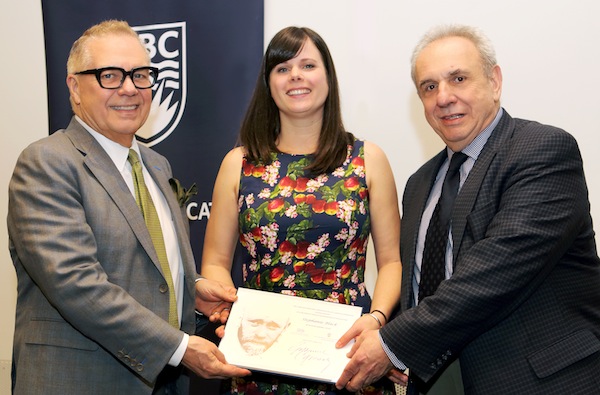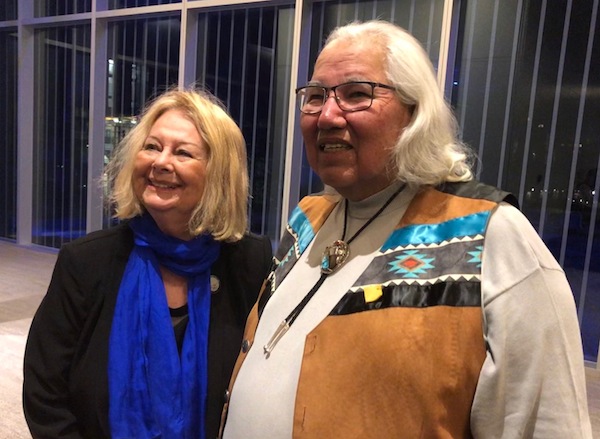Lillian Boraks-Nemetz and Senator Murray Sinclair. (photo by Jerry Nussbaum)
A succession of unjust Canadian laws piled one upon the other in the last part of the 19th century, enabling the federal government to take indigenous children from their homes and eradicate their cultural identities. The full scope of those laws – and their impacts on generations of First Nations people to today – was outlined by Senator Murray Sinclair, former head of the Truth and Reconciliation Commission, who spoke at the University of British Columbia last week.
The impact of residential schools and the laws that created and sustained them was the theme of Sinclair’s talk, which was presented by the UBC faculty of education and the Janusz Korczak Association of Canada.
Prior to Sinclair’s presentation, Vancouver author Lillian Boraks-Nemetz, a board member of the Korzcak association and a child survivor of the Holocaust, contextualized the lecture in the spirit of Korczak’s legacy.
Korczak was an educator and pedagogue who ran orphanages, including one in the Warsaw Ghetto, where Boraks-Nemetz was also confined. Korczak was a respected figure in Polish society, considered by many the originator of the concept of children’s rights.

“Korczak observed and listened to children, never judging, criticizing or showing intolerance,” said Boraks-Nemetz. He cultivated their self-esteem and believed that children should grow into who they want to be, not who others want them to become.
“During the Nazi persecution, Korczak, when offered a reprieve from the depredations of the Warsaw Ghetto, he would not abandon his children in their last journey to the cattle cars heading for Treblinka, the death camp,” she said. “He refused, saying, ‘My children need me. I deplore desertion.’ He went with them and they all perished.”
Sinclair then painstakingly outlined the conspiracy of legal barriers to justice that the government erected to perpetuate what has been termed cultural genocide.
As the federal government began to expand Canada westward in the 1870s, it entered into treaties with the indigenous peoples. One of the demands indigenous negotiators insisted upon in exchange for being limited to reserves was that the federal government create and fund schools on those reserves.
Sir John A. Macdonald sent a representative to the United States to see how they were running schools for Native Americans. In direct repudiation of the treaties, the federal government opted for a similar system and his government created what they called “industrial schools.”
Sinclair said MacDonald believed that, if children went to school on reserves, “the kids would go to the schools in the daytime and they would then return home to their parents, who are nothing but savages, and we would be teaching those children basic skills that all children learn from schools and what we’re going to end up with at the end of the day is nothing but savages who can read and write.”
Because the government wanted to “do it on the cheap,” said Sinclair, “they decided to involve the churches, who were quite willing to get involved because it was great for the churches as well to gain numbers through their missionary zeal.”
Children were punished for speaking their languages and for talking with their friends and siblings, “because they wanted to break your ties to those relationships…. Everything was done in the schools to break down cultural bonds that existed in those children.”
Those who were not physically or sexually abused lived in fear that they would be, Sinclair said.
“And, of course, the children, when they came home, would tell their parents what happened in those schools,” he said.
The natural inclination to stop it from happening led to a cascade of legislative injunctions that took away the most fundamental rights of First Nations peoples.
“In the 1880s, the government passed the law that amended the Indian Act and said that it was an offence, a legal breach of law, if you did not send your child to a school when the Indian agent told you to send the child,” said Sinclair.
When parents tried to hide their children, the parents would be prosecuted and go to jail. Faced with the prospect of indigenous people taking the government to court over the issue, the government passed another law, making it impossible to go to court against the government for anything done under the Indian Act “unless you get permission from the minister of Indian Affairs first.” The government soon made it illegal for indigenous people to consult with a lawyer on anything relating to the Indian Act – with the punishment for the lawyer being disbarment. Then, another step was added, making it illegal for a white Canadian to speak to a lawyer on behalf of an indigenous person.
When it seemed parents might protest the situation, the government made it illegal, in 1892, for three or more First Nations people to gather together in order to discuss a grievance against the government of Canada. It was made illegal for indigenous people to attend large gatherings like the traditional sundances or the potlatch, “not just because of the religious aspect of it but also because, at these gatherings, that’s when Indians got together in order to discuss their grievances,” said Sinclair.
Fears of a violent uprising were dismissed by Northwest Mounted Police in documentation Sinclair has seen, which, he summarized: “We don’t have to worry about the Indians taking up arms against the government because we have their kids. They are not going to go to war against us.”
Children who returned from the schools were scarred and often unable to communicate with their parents in a shared language.
“Their ability to know how to hunt, fish or trap, which is what the communities depended upon, was lost to them,” said Sinclair.
Estimates are that about 35% of indigenous children attended residential schools, but the damage extended to the other 65%, who were taught in public schools the same white superiority/indigenous inferiority curriculum as those who were taken away.
When those children grew up and had children, they had no learned skills at parenting and were burdened with their own demons, said Sinclair. As a result, when child welfare systems were burgeoning in the 1950s, it was mostly indigenous children who went into care. It was, and is, disproportionately indigenous people who are incarcerated.
Indigenous Canadians have the highest suicide rates of any cultural group in the world, said Sinclair. High school dropout rates, substance abuse and violent crime affect indigenous Canadians in exponentially greater numbers than non-indigenous Canadians.
The problems will not be resolved, Sinclair said, by spending more money on child welfare, policing or incarceration. The education system and society must help indigenous young people realize who they are as Anishinaabe, Cree, Sto:lo or Mohawk.
“The educational system is just not giving them what they need,” he said. “We have a lot of work to do, but, if we address that one aspect of how our society is functioning, we will see the most dramatic change that will resolve or redress the history of residential schools in Canada on indigenous people, on indigenous youth in particular.… It begins with recognizing that … indigenous youth, in particular, must be given their chance to develop their sense of self-respect first, and that’s going to take some time to do.”

